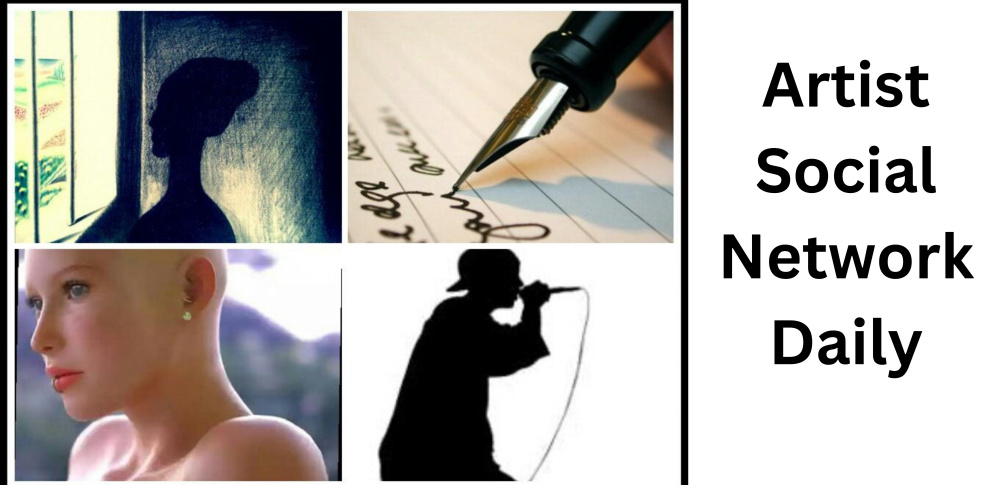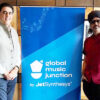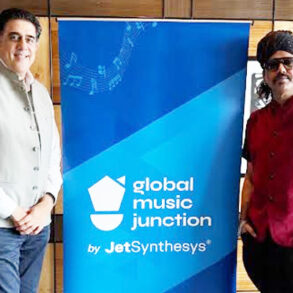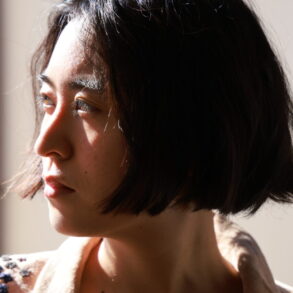Arts & Entertainment Community
Tacoma Community College’s Gig Harbor campus recently held an opening reception for “Collaborative Identity: A Dual Exhibition,” featuring art by award-winning Korean American visual artists Emily Jounghee Won and Hannah Kyungsook Ra.
Won works with wire, canvas, and paint to create what she calls “wire drawings,” while Ra is a fine art painter. They brought their distinct mediums together to show that identity is not static, and that art can create boundary-crossing, difference-bridging meaning between two people. The artists told Gig Harbor Now about their artistic journeys and their work together.
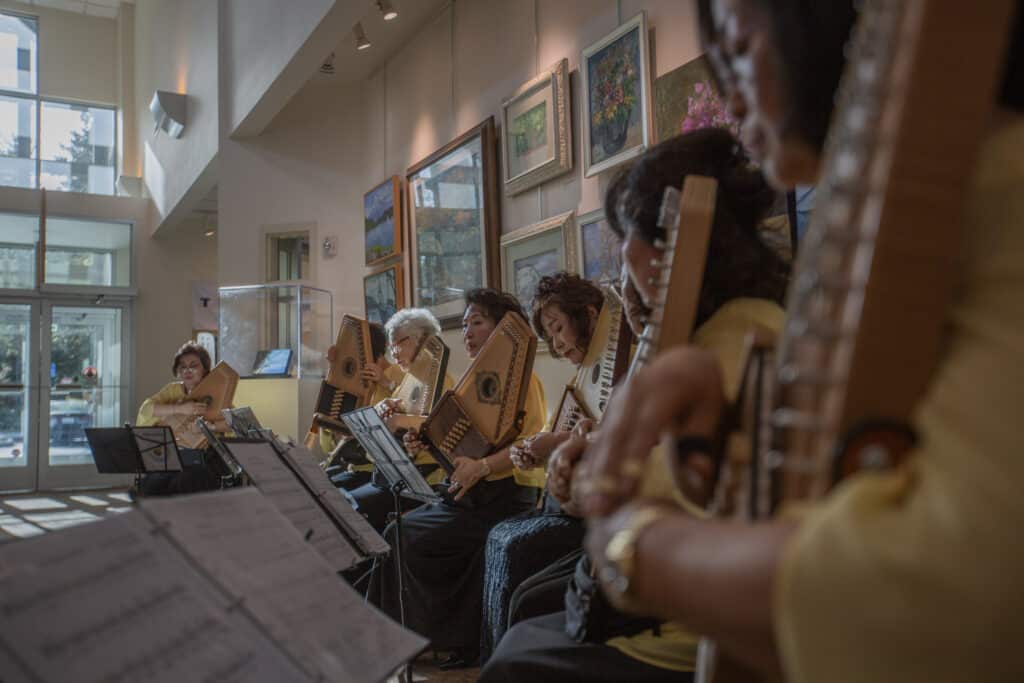
Artist Hannah Kyungsook Ra, far left, performs, during a reception for the opening of “Collaborative Identity” at Tacoma Community College’s Gig Harbor campus on April 10, 2025. Photo by Carolyn Bick. © Carolyn Bick
Gig Harbor Now: Tell me a little bit about your background. What were your experiences like that shaped who you are as an artist?
Won: I’d like to share a little bit about my journey. I moved to the U.S. 10 years ago as an international student, even though I had already earned my Master’s in Fine Arts. Around that time, I began working with copper wire, creating what I call “wire drawings” rather than wire sculptures because I use wire like a pencil to draw expressive human figures and their emotions.
As a student in the U.S., I wanted to explore new forms of art, so I studied photography, graphic design, and digital media. This opened up opportunities for me to combine different mediums. Over time, I began blending copper wire drawing with photography and acrylic painting, resulting in layered, experimental works.
After three years of studying photography and digital art, I entered a master’s program in photography at (California State University) Fresno. There, I focused on the Codex Borgia, a Mesoamerican manuscript that documents indigenous life before and after the Spanish conquest. I was deeply moved by the symbolic language and everyday imagery, especially considering how much of their culture was erased — yet these visual records survived. It reminded me of Korea’s history during the Japanese occupation and how symbols can endure even when culture is suppressed.
As an immigrant mother, I had to focus on adjusting to life in a new country. This experience of starting over and constantly learning shaped my identity. It’s not fixed—I don’t see myself as solely Korean or American. Instead, I embrace the fluidity of culture. I believe different perspectives can coexist and fuse together to create something new.
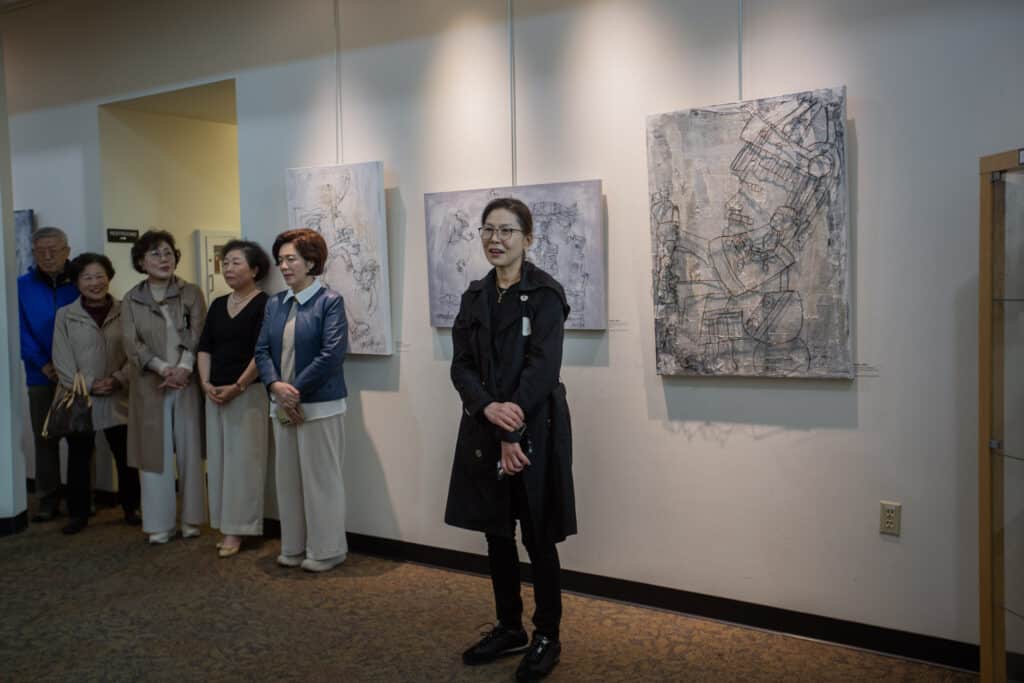



Artist Emily J. Won addresses reception attendees at the reception for the opening of “Collaborative Identity.” Some of her artwork can be seen behind her. Photo by Carolyn Bick. © Carolyn Bick
Hannah Kyungsook Ra: When I was young, my parents helped me experience the beauty of lines and colors through nature, allowing me to feel them firsthand. I also remember being drawn to the curved lines of traditional Korean shoes and beoseon (traditional Korean socks), as well as the graceful contours of Korean-style rooftops, all introduced to me by my parents.
GHN: What attracted you to art in the first place, and what did you fall in love with in your specific medium or mediums?
Won: Art has always been a part of my life — almost like a natural extension of who I am. From a very young age, I found joy in creative expression. My mother often told me that I was constantly drawing, painting, and making things, completely absorbed in artistic activities. That’s likely why I’ve always felt a deep connection to all forms of art.
When I was an undergraduate student, I was introduced to many different forms of art, such as installation works that extended beyond traditional gallery spaces, earth art, and even graffiti. These experiences broadened my understanding of what art could be. Inspired by them, I created human figures using gold-colored copper wire and presented an installation where viewers could only see the shadows of the artwork, not the pieces themselves. I wanted my art to feel playful and approachable because shadows are always shifting and alive, constantly transforming with the light.
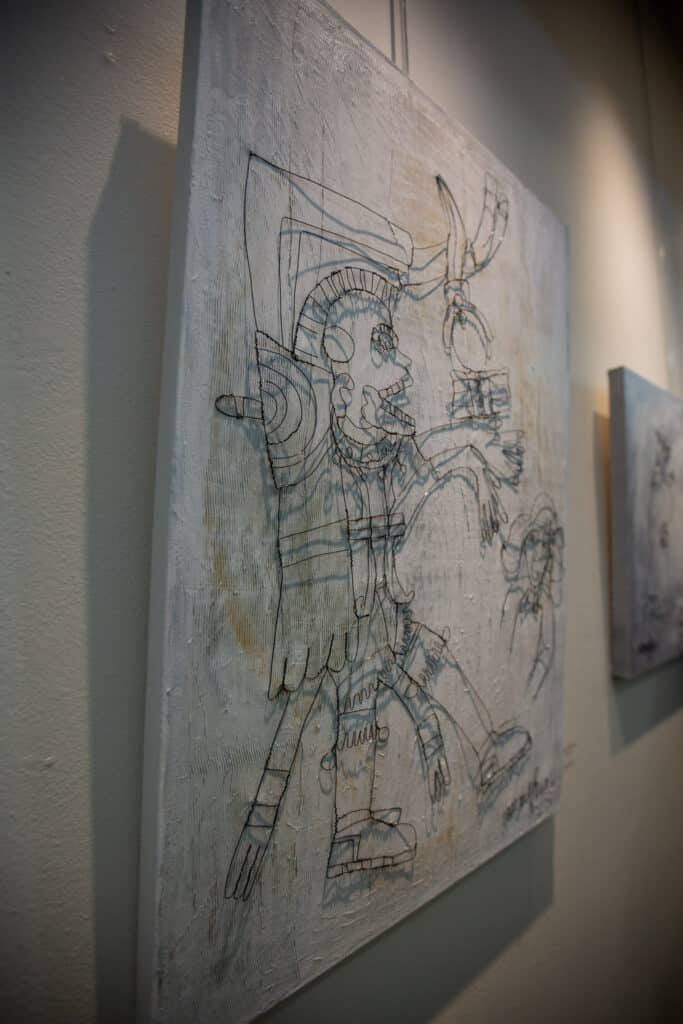



A piece by Emily J. Won, as photographed at the reception for the opening of “Collaborative Identity.” Photo by Carolyn Bick. © Carolyn Bick
I still keep the guestbook from my second solo exhibition in 1997. One high school student wrote a message I’ll never forget: “Your art is very, very fun. I’m not good at art, but after seeing your exhibition, I started to like it.” That simple note meant so much to me and has stayed with me ever since.
Since then, my work has continued to evolve through various mediums. Over time, I’ve felt a growing desire to combine different art forms in my practice — to show that diverse expressions can not only coexist but also connect in meaningful ways.
Ra: I’ve always been drawn to the distinct characteristics and feelings I perceive in people and things, and I’ve wanted to express those unique visions in a beautiful way. Now, I aim to portray the essence of nature and the deeper meaning of life more directly through my work.
GHN: How did you two meet, and when did you decide to start working together, either in general or on Collaborative Identity?
Won: In 2021, I participated in an art competition with the theme “The Story of Korea” and received an Honorable Mention. After the competition, I joined … the Korean American Artists Association. In 2023, Hannah was serving as president of the association, and we became interested in each other’s artwork. She later invited me to collaborate on a dual exhibition at the TCC Gig Harbor branch, and that’s how I became part of this show.
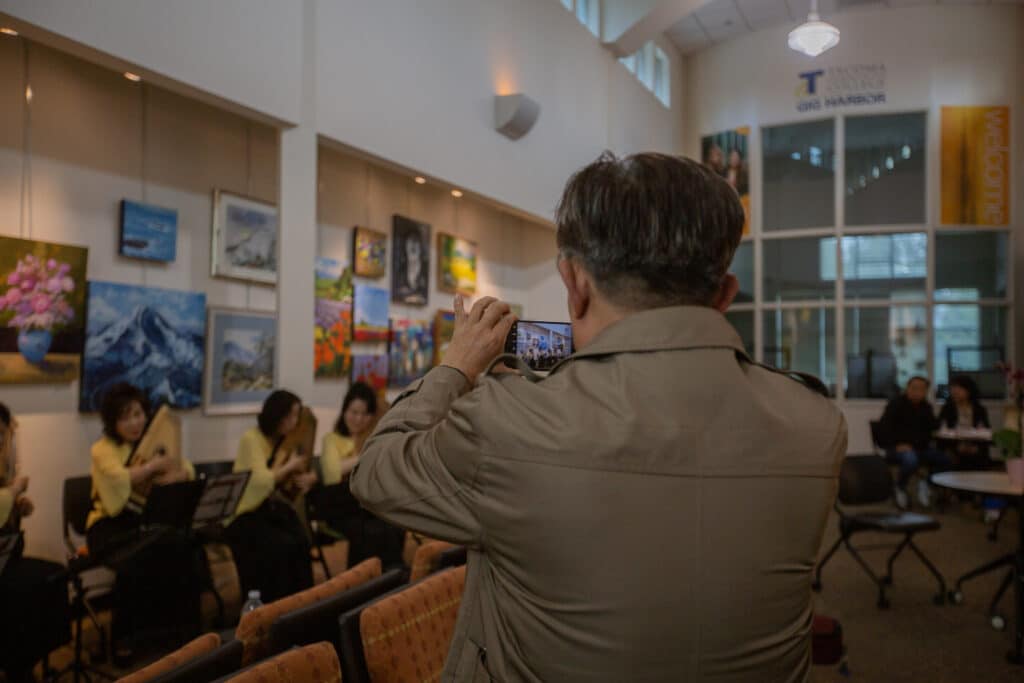



A guest takes a picture of the performers, during a reception for the opening of “Collaborative Identity.” Photo by Carolyn Bick. © Carolyn Bick
GHN: How did Collaborative Identity come about? What inspired this collaboration and how long did it take you to create? What does it mean to each of you?
Won: Our representative artwork in this exhibition, Collaborative Identity, is an experimental piece. Hannah and I began discussing the idea for this show more than six months ago. We knew from the start that, even though we work with completely different mediums, we could create something powerful and meaningful together.
We first agreed on using a bold, energetic color — yellow, like the feeling of spring. Then, we decided to bring in my copper wire drawings to represent identity in collaboration. Although we are both Korean, we now live in the U.S., and we each express ourselves through very different mediums. Still, we found a strong connection through our shared sense of identity.
I also wanted to incorporate symbols from the Codex Borgia because even though the Spanish conquest destroyed much of the Mesoamerican culture, a few manuscripts survived. That survival through art and symbol deeply moved me. I hoped to bring together that sense of resilience and cultural memory into this piece.
GHN: I read the Forward to Collaborative Identity, but I would like to hear in your words how you each feel your work marries together.
Won: Hannah’s vibrant yellow background — symbolizing energy — paired with my instinctual wire drawings and deconstructed symbols from the Codex Borgia represents a merging of past and present, tradition and transformation. This work speaks to the idea of collaborative identity — where differences become strengths, and shared creativity gives birth to new meaning.
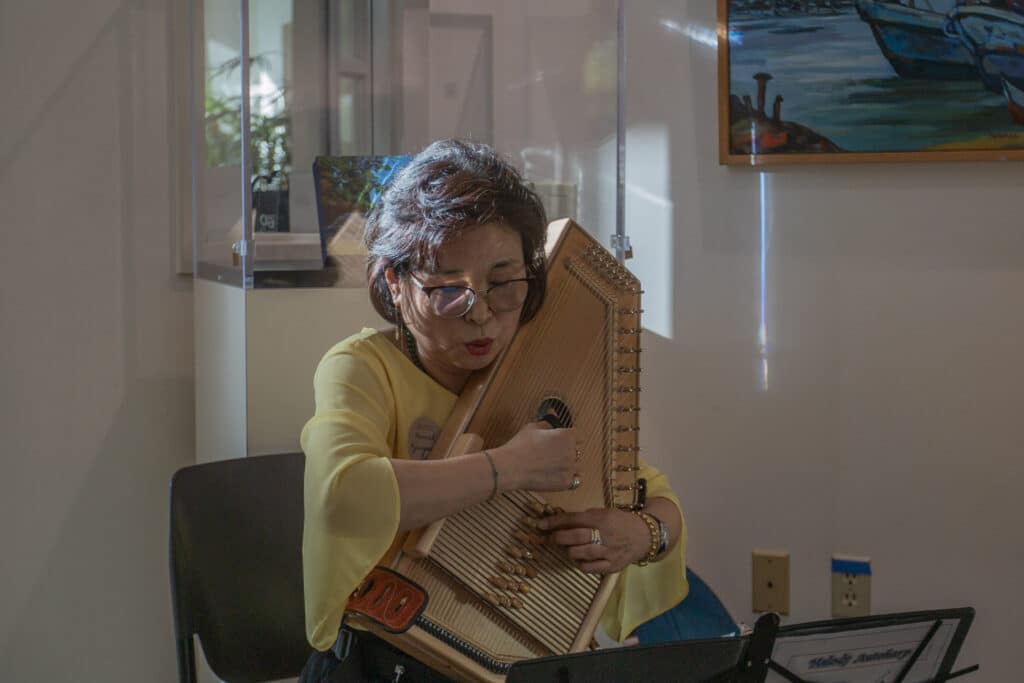



Artist Hannah Kyungsook Ra performs during a reception for the opening of “Collaborative Identity.” Ra’s artwork can be seen behind her. Photo by Carolyn Bick. © Carolyn Bick
Ra: When we collaborated on this exhibition for the first time, it was scheduled to be held in April, so I wanted to capture the feeling of spring. I created the background using an acrylic painting, and Emily’s black wire artwork stood out beautifully against the yellow color.
GHN: Is there anything else you want readers to know?
Won: I believe there are no boundaries in art. In many ways, I think we live within art — it surrounds us and moves through us. Whether traditional or contemporary, I see all forms of art as interconnected. As they evolve, they continue to shape one another and contribute to a shared creative identity. I even believe that our thoughts and words can become a form of art.
“Collaborative Identity” is on display at Tacoma Community College’s Gig Harbor campus until June 9, 2025.
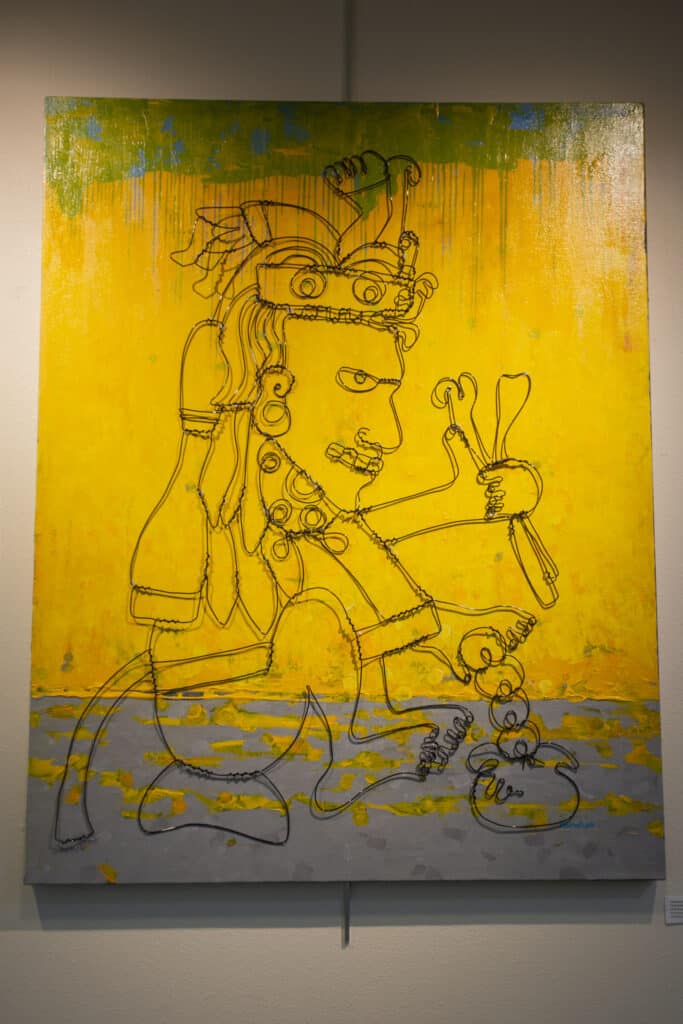



A piece co-created by artists Hannah Kyungsook Ra and Emily J. Won, as photographed at the reception for the opening of “Collaborative Identity.” Photo by Carolyn Bick. © Carolyn Bick
This post was originally published on this site be sure to check out more of their content
